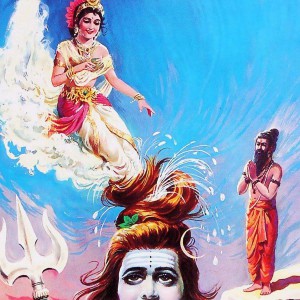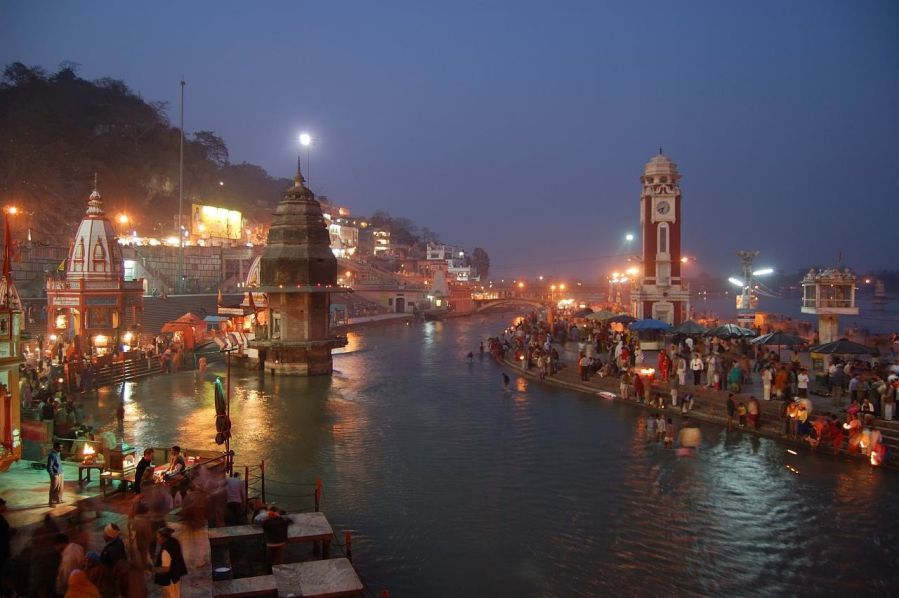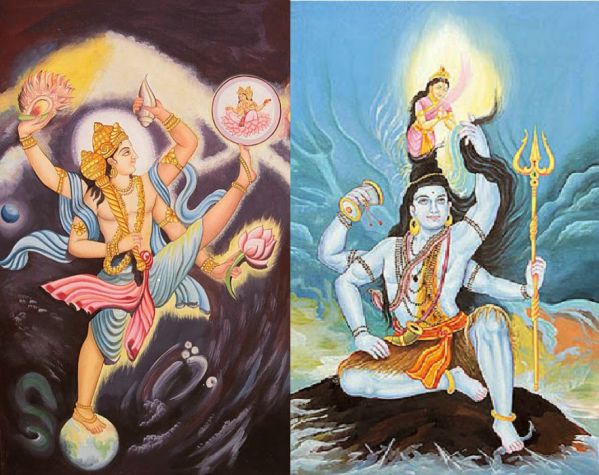No products in the cart.
Ganga, or the Ganges, the holy river of the Hindus, has its source at Gangotri in the Himalayas from where it flows for a distance of 2,400 km. to fall into the Bay of Bengal. Ganga is a major river of the Indian subcontinent, associated in myth and reality with the land and people of India as well as neighboring countries like Bangladesh.
In the move to Aryanism the Ganga basin, when the Vedic people shifted focus from the Indus to the Ganga, a myth evolved that Ganga would take on all the sins of the world. Thereafter, people have religiously bathed in her waters to cleanse themselves of sin. Gangajal (water of Ganga) is widely used in religious ceremonies. The holy sight of Ganges gives knowledge, splendors, name, fame etc. The gravest of sins like Brahmahatya (killing of a Brahmin) and Gauhatya (killing of a cow) gets absolved by the mere touch of Ganga’s holy water. Lord Vishnu himself has described the importance of river Ganges in the following way: he says to Garuda – the eagle God, his divine vahana (vehicle):
“Thousands of man’s sins get destroyed by the holy sight of the Ganges, and he becomes pure by the touch of the water of Ganges, by consuming it, or just by pronouncing ‘Ganga – Ganga'”
For this reason Ganges is also called the savior of this world.
There are many versions of stories regarding the origin of Ganges. The river Ganga is said to have originated when Lord Brahma (one of the Supreme forms of divinity) washed the feet of Lord Vishnu in His incarnation as Vaamana – the dwarf Brahmin. When He (Lord Vishnu, as Vaamana) measured the world in three steps, the nails on His left foot caused a pore on the upper side of the universe from where Ganga fell down into heaven.
According to Valmiki Ramayana, Ganges was the daughter of Himalaya and Menaka. The deities abducted her and took her to heaven. From that time onwards Ganga started living inside the Karmandala (a spout shaped vessel). According to Krittivas’ Ramayana the deities had taken Ganga to Lord Shiva to get married with him. When Menaka did not find her in the house, she cursed Ganga to attain the form of water.
The Vishnu Purana describes the birth of Ganga in the following manner: She is said to have originated from the big toe of Lord Vishnu’s left foot. Dhruvah, the pole star, received her in her descent and sustained her day and night on his head, while the seven Rishis (the Pleiades) performed their ablutions in her waters (because the Pleiades revolve around the Pole Star). Ganga then encompassed the orb of the Moon by her currents, which added to the luminary’s brilliance. Thereafter, having issued from the Moon, she alit upon Mount Meru, and then flowed in four branches to the four corners of the Earth for the sake of its purification. The name of these branches are Sita, Alakananda, Chaksu and Bhadra. The southern branch, Alakananda, was held affectionately by Lord Shiva on His head for one hundred divine years and then was released from His matted locks. Hence Lord Shiva is depicted in Indian iconography with a crescent Moon on his head, from where a shoot of water springs forth. Thereafter, the southern branch of Ganga journeyed through India and divided itself into seven rivers which flow into the southern ocean. Hence Alakananda is known as the most sacred river of the four branches.
According to another version, Goddess Ganga, once lived on Mount Kailash and flowed demurely for the sole pleasure of the Gods. Legend has that Sagar, King of Oudh, the 13th ancestor of Lord Rama, the descendent of Sun God (Suryavanshi), had performed the Ashwamedha Yagna, or the horse-sacrifice, 99 times. This ceremony consisted in sending a horse round the Indian world, with defiance to all the earth to arrest its progress. If the horse returned unopposed, it was understood to be acquiescence in the supremacy of the king, and the horse was then solemnly sacrificed to the gods. When King Sagar made preparations for the 100th sacrifice, Indra, King of Heaven, who had himself performed the ceremony a 100 times, jealous of being displaced by this new rival, stole the horse, and concealed it in a subterranean cell, where the sage Kapila, or Kapila Muni, was absorbed in meditation, dead to all occurrences of the external world.
The sixty thousand sons of Sagar traced the horse to its hiding place, and believing the sage to be the author of the theft assaulted him. The holy man being thus roused opened his eyes and cursed the assailants, who were immediately burnt to ashes and sentenced to hell. Sagar heard of this fate through Narada (devotee of Lord Narayana), the heavenly wonderer, and sent the grandson Ansuman to undo the harm. Ansuman descended to the underworld and met Kapila, who was much pleased with the youth’s bearing and conversation. He granted that the souls of the sons of Sagar may be released by the waters of Ganga, then resident in heaven. Despite much austerity and prayer, neither Sagar nor Ansuman after him, nor his son Dilip could get Ganga to appear on earth.
Finally it was Dilip’s son Bhagiratha, who after severe austerities, propitiated the Goddess, and she agreed to come down to earth and then to the nether world to rescue the tormented souls of the sons of Sagar. However, the impact of her fall would be so severe, that it could be borne by none less than Lord Shiva himself. Therefore Bhagiratha went into meditation again and obtained Shiva’s consent after many more austerities. Finally, the river came down and fell into Lord Shiva’s matted hair, (this manifestation of Lord Shiva is known as Gangadhara), from where she separated into seven streams, of which three flowed to the west and three to the west. The seventh stream followed Bhagiratha to earth and then to the nether worlds.
Bhagiratha patiently led the river down to the sea from the Himalayas and for this reason the Ganges is also known as the Bhagirathi. However, being unable to locate the exact spot where the ashes lay, he requested Ganga to follow her own course. The Ganga, therefore in the region of Bengal, divided herself into a hundred mouths and formed the Ganges delta. One of these streams washed the ashes, and offered salvation to the souls of the departed. In this way the children of Sagar were saved and an ocean formed from the waters there. This is the Sagar Island of today, where the Ganges flows into the Bay of Bengal, where a bath at the confluence of the river and the sea is considered to be sacred on Makara Sankranti (mid-January).
 Thus on the tenth day of the bright half of Jyeshthah (last week of May), Goddess Ganga began to flow from heaven to the matted hair of Lord Shiva, and from the hair of Lord Shiva she began to flow on earth. The first ten days of the month of Jyeshthah (last week of May), known as Dashahara, are dedicated to honour the river Ganges, or Mother Ganges. The Ganges is believed to flow in the three worlds – heaven, earth and the nether world (patala- where the ashes of the sixty thousand sons of King Sagar lay): Thus the Ganga is known as “Three Path River”. People believe that by bathing in the Ganga sins are washed away. The principle centers for the worship of the Ganga are Gangotri, the source of the river; Haridwar, where she comes down to the plains; Allahabad, where she joins the Yamuna; Varanasi, the holy city; and Sagar Island in her estuary where she finally flows into the Bay of Bengal.
Thus on the tenth day of the bright half of Jyeshthah (last week of May), Goddess Ganga began to flow from heaven to the matted hair of Lord Shiva, and from the hair of Lord Shiva she began to flow on earth. The first ten days of the month of Jyeshthah (last week of May), known as Dashahara, are dedicated to honour the river Ganges, or Mother Ganges. The Ganges is believed to flow in the three worlds – heaven, earth and the nether world (patala- where the ashes of the sixty thousand sons of King Sagar lay): Thus the Ganga is known as “Three Path River”. People believe that by bathing in the Ganga sins are washed away. The principle centers for the worship of the Ganga are Gangotri, the source of the river; Haridwar, where she comes down to the plains; Allahabad, where she joins the Yamuna; Varanasi, the holy city; and Sagar Island in her estuary where she finally flows into the Bay of Bengal.
Another legend regarding Ganga has it that Ganga followed Bhagiratha and because of his tremendous speed, all the villages, forests etc. in the way were either getting submerged or drowned. Sage Jahnuh who was doing a yagna in his hermitage got angry when his hermitage was submerged in the Ganga. He drank whole of the Ganga by his yogic power. At this the deities, and the men became restless and they requested Jahnuh to release Ganga. Jahnuh released Ganga from his thigh by cutting it and for this reason Ganga is also called “Jahnvi” or “Jahnusta”.
The Shiva Purana mentions that the son of Lord Shiva was destined to salvage Earth by leading the Devatas – the divine forces – to drive out the Asuras – the evil forces – who had taken possession of the planet. In order to hasten the birth of this divine son, the Gods decided to steal Lord Shiva’s Bija (seed) by interrupting his love play with his consort, Goddess Parvati, at the precise moment of emergence of the Bija from Lord Shiva. The interruption of the love making process led to the precious seed to fall on the ground. Agni – the Fire God, assumed the form of a white dove and picked up the Bija in its beak and flew away. Having emerged from Lord Shiva himself, the seed had immense power and fire stored within it – so much so that even Lord Agni found it difficult to keep holding it in his beak and he let go off it and dropped it in the Ganges. Ganga then carried the seed with her for long, and as instructed by Lord Brahma, deposited it in a sacred reed grove in the Saravana forest, situated on her shores, where the divine child was born after 10,000 years. Lord Shiva then proclaimed that this celestial child be known by six different names, to be known as the son of six different creators. He was to be known as Kartikeya as the son of the Kritikas or the six sacred Pleiades, whose wives had nourished him. As the son of Agni he was to be known as Mahasena. As the forest Saravena’s son, he was to be known as Saravana. As Parvati’s son he would be known as Skanda and as his own, as Guha. And finally, Lord Shiva proclaimed that the child would be known as Kumara, as the son of Ganga.







